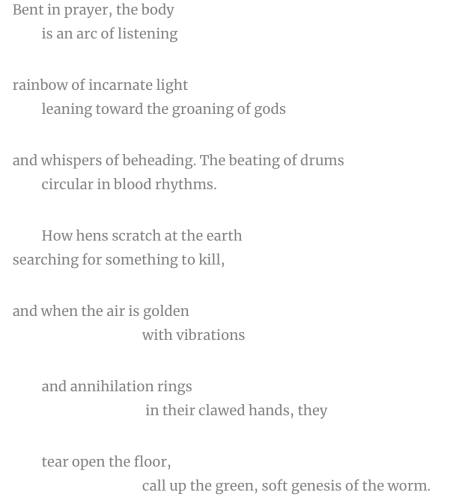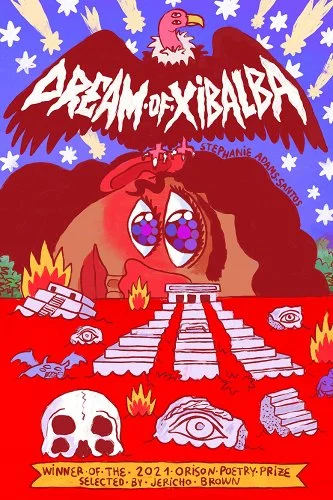Described as an “incantatory long poem, [that] draws the reader into a dreamworld where the barrier between life and death grows porous, populated by ancestors and spirits,” Dream of Xibalba by Stephanie Adams-Santos is hard to give a synopsis of. The difficulty risked in the book avoids easy summary. A note in the table of contents provides a clue into this difficulty: “[This is a]poem in twelve parts, as in the hours of a clock. The fragments are untitled; the following are first lines.” The word fragment implies an incomplete nature and a lack of resolution.
If a whole narrative isn’t accessible here, what is accessible are the fragments of connection.
If a whole narrative isn’t accessible here, what is accessible are the fragments of connection. One doesn’t “complete” the individual poems of this book; rather, one becomes animated by them. This is the gift of the book. Nonetheless, one is encouraged to do some research before reading the book. It helps, for example, to know a bit about Xibalba and Mayan mythology. In an interview, the poet shares:
Xibalba is the name of the Mayan underworld — “place of fright.” The terrifying lords there are responsible for all the forms of mortal suffering that exist in the world. As horrific as Xibalba is — rivers of pus, scorpions, and blood — its imaginative rendering is exquisitely creative and fertile and quite playful.
Of particular relevance here is the juxtaposition of horror and mythology. While horror implies shock and reaction, mythology offers foundational points of reference. Another way to view this juxtaposition is in terms of chaos on one side and order on the other.
Dream of Xibalba encourages one to read intuitively
Dream of Xibalba encourages one to read intuitively, following the turns of each fragment individually while at the same time sensing connections across phrasing, imagery, and repetition. An example of this intention at work occurs around the image of a hen, which appears first early in the book-length poem:
chh chh chh The hens tear open the earth
with their sun-colored hands.
Wake up!
There are rumors about you
the Strangers pass amongst themselves.
They don’t know,
they don’t know
pain is a flower
that blooms in the eye.
This fragment starts by first mirroring the sound of a hen scratching at the earth. The centering of this sound points to the outside world in acknowledgment of the limits of language but also of the shock of waking. There is alarm in these lines, a push to “wake up!” as well as to make clear a sense of danger. The ending couplet, “pain is a flower / that blooms in the eye,” brings the reader into the body. The alarm and jolt sensed and encountered have a physical location: the widening eye. When this hen fragment is echoed later in the poem, it brings to mind both this sense of waking, not just to the day but to a consciousness:

Here, the body “is an arc of listening,” which mirrors the widening eye above in the way it grounds consciousness in the body, implying again how inseparable the mind and body are for the living. When the hen reappears, they are still scratching at the earth. The difference this time around is that the alarm from the earlier fragment is recast as an inevitable drive toward survival. The repeated image conveys how existence is constrained by the need to survive. In this way, one can see the aim of this collection is, in part, to explore and interrogate what it means to be conscious beings gifted with imagination and dreams while also tethered to the physical realm.
We are invited to become as malleable as dreams.
While dreams offer the writer flexibility and range in imagination, they also ask of the reader something akin to but not quite suspension of disbelief, more a lyric engagement with belief. We are invited to become as malleable as dreams. In the same interview cited above, the poet also shares:
I let the ghosts in myself speak. I let sense-memory guide me. I let the fragments mingle together and become the body of the book. That was the major discovery for me — that we don’t need wholeness or healing or perfect memory or foresight or knowledge or facts or even comprehension. It’s okay to just be. Incomplete and without resolution.
This feeling of being “incomplete and without resolution” may at first seem antithetical to the experience of poetry. Yet, in a way, this collection is one of self-invocation. If, as is said midway through the collection, “Your tongue, the serpent, / leads you home to yourself,” then we, the readers, are implied in the chaos and to dream ourselves into it.



